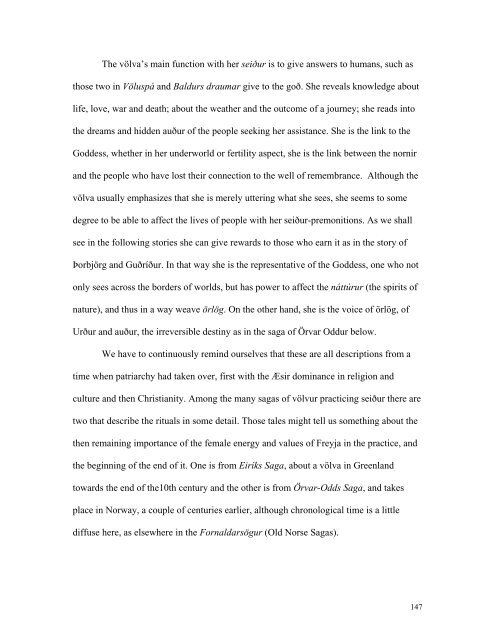You also want an ePaper? Increase the reach of your titles
YUMPU automatically turns print PDFs into web optimized ePapers that Google loves.
<strong>The</strong> völva’s main function with her seiður is to give answers to humans, such as<br />
those two in Völuspá <strong>and</strong> Baldurs draumar give to the goð. She reveals knowledge about<br />
life, love, war <strong>and</strong> death; about the weather <strong>and</strong> the outcome <strong>of</strong> a journey; she reads into<br />
the dreams <strong>and</strong> hidden auður <strong>of</strong> the people seeking her assistance. She is the link to the<br />
Goddess, whether in her underworld or fertility aspect, she is the link between the nornir<br />
<strong>and</strong> the people who have lost their connection to the well <strong>of</strong> remembrance. Although the<br />
völva usually emphasizes that she is merely uttering what she sees, she seems to some<br />
degree to be able to affect the lives <strong>of</strong> people with her seiður-premonitions. As we shall<br />
see in the following stories she can give rewards to those who earn it as in the story <strong>of</strong><br />
Þorbjörg <strong>and</strong> Guðríður. In that way she is the representative <strong>of</strong> the Goddess, one who not<br />
only sees across the borders <strong>of</strong> worlds, but has power to affect the náttúrur (the spirits <strong>of</strong><br />
nature), <strong>and</strong> thus in a way weave örlög. On the other h<strong>and</strong>, she is the voice <strong>of</strong> örlög, <strong>of</strong><br />
Urður <strong>and</strong> auður, the irreversible destiny as in the saga <strong>of</strong> Örvar Oddur below.<br />
We have to continuously remind ourselves that these are all descriptions from a<br />
time when patriarchy had taken over, first with the Æsir dominance in religion <strong>and</strong><br />
culture <strong>and</strong> then Christianity. Among the many sagas <strong>of</strong> völvur practicing seiður there are<br />
two that describe the rituals in some detail. Those tales might tell us something about the<br />
then remaining importance <strong>of</strong> the female energy <strong>and</strong> values <strong>of</strong> Freyja in the practice, <strong>and</strong><br />
the beginning <strong>of</strong> the end <strong>of</strong> it. One is from Eiríks <strong>Saga</strong>, about a völva in Greenl<strong>and</strong><br />
towards the end <strong>of</strong> the10th century <strong>and</strong> the other is from Örvar-Odds <strong>Saga</strong>, <strong>and</strong> takes<br />
place in Norway, a couple <strong>of</strong> centuries earlier, although chronological time is a little<br />
diffuse here, as elsewhere in the Fornaldarsögur (Old Norse <strong>Saga</strong>s).<br />
147


